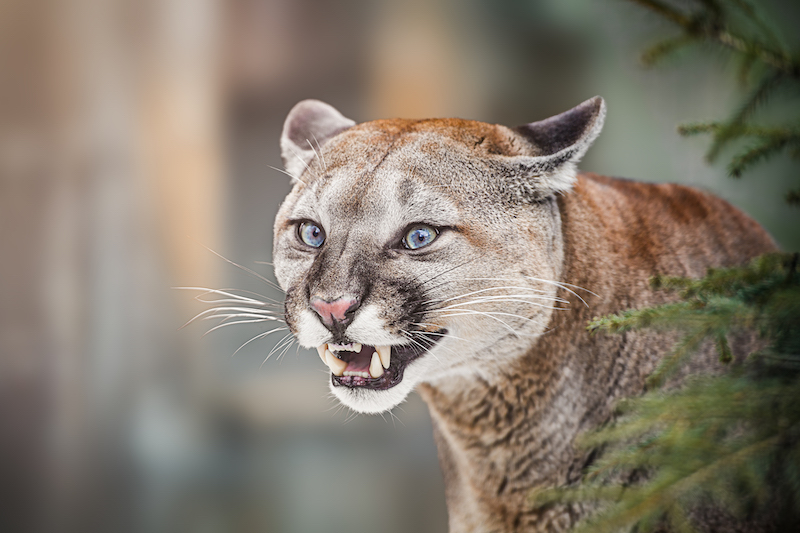Have you ever spotted a big cat in the wild and wondered if it was a mountain lion or a bobcat? While these two wildcats might look somewhat similar at a glance, they have many distinct differences. In this guide, we’ll break down everything you need to know about mountain lions and bobcats, from their physical characteristics to their behaviors and habitats. Let’s dive in!
| Mountain Lion | Bobcat |
|---|---|
 |  |
Physical Characteristics of Mountain Lion And Bobcat
Mountain Lion (Puma concolor)
Mountain lions, also known as pumas, cougars, or panthers, are much larger than bobcats. Adult male mountain lions can weigh between 120 to 220 pounds, while females range from 65 to 140 pounds. These majestic cats can grow up to six feet long, with a tail that adds another two and a half to three feet. Their coats are solid in color, typically ranging from light brown to gray, and they are known for their long tails and strong, muscular builds.
Bobcat (Lynx rufus)
Bobcats, also known as wildcats, are significantly smaller. Adult bobcats weigh between 15 to 40 pounds, with males being on the larger end of the spectrum. They are about 2 to 4 feet long, including their short, bobbed tails. Bobcats have distinctive mottled fur with black spots and streaks, and their coats can range from reddish-brown to gray. They also have tufts of fur on the tips of their ears and longer fur on the sides of their heads, giving them a unique appearance.
Habitat and Range of Mountain Lion And Bobcat
Mountain Lions
Mountain lions are incredibly adaptable and can be found in a variety of habitats across North, Central, and South America. In the United States, they are predominantly found in the western states and Florida. These solitary animals prefer remote mountainous areas, hilly regions, and canyonlands. They have large home ranges, often spanning over 100 square miles.
Bobcats
Bobcats are primarily found in North America, from southern Canada to northern Mexico. They thrive in diverse environments, including forests, swamps, deserts, and even suburban areas. Bobcats are more adaptable to human encroachment and can often be found near urban park borders where their prey, such as rabbits and quail, is abundant.
Behavior and Diet of Mountain Lion And Bobcat
Mountain Lions
Mountain lions are powerful predators capable of taking down prey much larger than themselves, including deer and even elk. They are known for their incredible leaping ability, capable of jumping up to 20 feet in a single bound. These cats are generally more aggressive than bobcats and may approach humans if they feel threatened or are hunting. If you encounter a mountain lion, it’s important to make yourself look as large as possible, wave your arms, and make loud noises to scare it away.
Bobcats
Bobcats are more timid and less likely to approach humans. Their diet consists mainly of small mammals, birds, and occasionally deer. They are excellent hunters with sharp senses and are more likely to run away if they encounter humans. Bobcats are typically active at night (nocturnal), which means they do most of their hunting after dark.
Unique Differences Between Mountain Lion And Bobcat
- Size and Strength: Mountain lions are much larger and stronger than bobcats.
- Tail Length: Mountain lions have long tails, while bobcats have short, bobbed tails.
- Fur Patterns: Mountain lions have solid-colored coats, whereas bobcats have spotted and streaked fur.
- Behavior: Mountain lions are more aggressive and likely to approach humans, while bobcats are more timid and elusive.
- Habitat Range: Mountain lions require large, remote habitats, whereas bobcats are more adaptable to various environments, including suburban areas.
Final Thoughts
While both mountain lion and bobcat belong to the cat family and share some similarities, their differences are quite pronounced. Whether you’re exploring the wilderness or spotting a big cat in your backyard, understanding these differences can help you identify which wildcat you’re seeing and how to react appropriately.
By knowing their physical characteristics, behaviors, and habitats, you can appreciate the unique qualities of each of these fascinating creatures. Stay safe and enjoy the beauty of these incredible wildcats in the wild!





